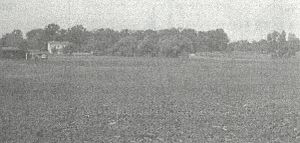Knoll Spring Site facts for kids
Quick facts for kids Knoll Spring Site |
|
|---|---|
 |
|
| Location | in the Sag Valley, Palos Hills, in Cook County near Chicago, Illinois |
| Lua error in Module:Location_map at line 420: attempt to index field 'wikibase' (a nil value). | |
The Knoll Spring site (also called 11Ck-19 or Au Sagaunashke Village) is a special place in the Sag Valley, near Palos Hills, Illinois. It's an archaeological site, which means it's a spot where scientists study how people lived long ago. This site helps us learn about Native American groups who lived here before European explorers arrived.
What is the Knoll Spring Site?
The Knoll Spring site is considered a "late Prehistoric" site. This means it was used by people just before written history began in this area. The people who lived here were part of the Upper Mississippian culture, specifically a group called the Huber people. They were Native Americans who lived in the area that is now Illinois.
Digging Up the Past: Archaeology at Knoll Spring
Archaeologists are like detectives who study the past by looking at objects people left behind. At the Knoll Spring site, they started finding things on the surface of the ground between 1964 and 1967.
Then, in 1966, they began carefully digging into the ground. This process is called an excavation. They published their findings in 1971, sharing what they learned with other scientists and the public.
What Makes Knoll Spring Special?
The objects found at Knoll Spring are very similar to those found at other Huber culture sites in the Chicago area. These include places like Huber, Hoxie Farm, Oak Forest, Palos, and Anker. By comparing items from these sites, archaeologists can learn more about the Huber people.
The Huber culture was one of the Native American groups that European explorers and fur traders met in the 1600s. We know this because some European trade goods, like beads or metal tools, have been found at other Huber sites such as Oak Forest and Palos. These items show that Native Americans and Europeans were trading with each other.
At first, researchers thought they found European trade goods at Knoll Spring too. However, later studies showed that these items probably came from a more recent time period and were not left by the Huber people. This means the Knoll Spring site mostly tells us about the Huber culture before they had much contact with Europeans.
Studying sites like Knoll Spring helps us understand the daily lives, tools, and traditions of the Native American people who lived in Illinois centuries ago.

